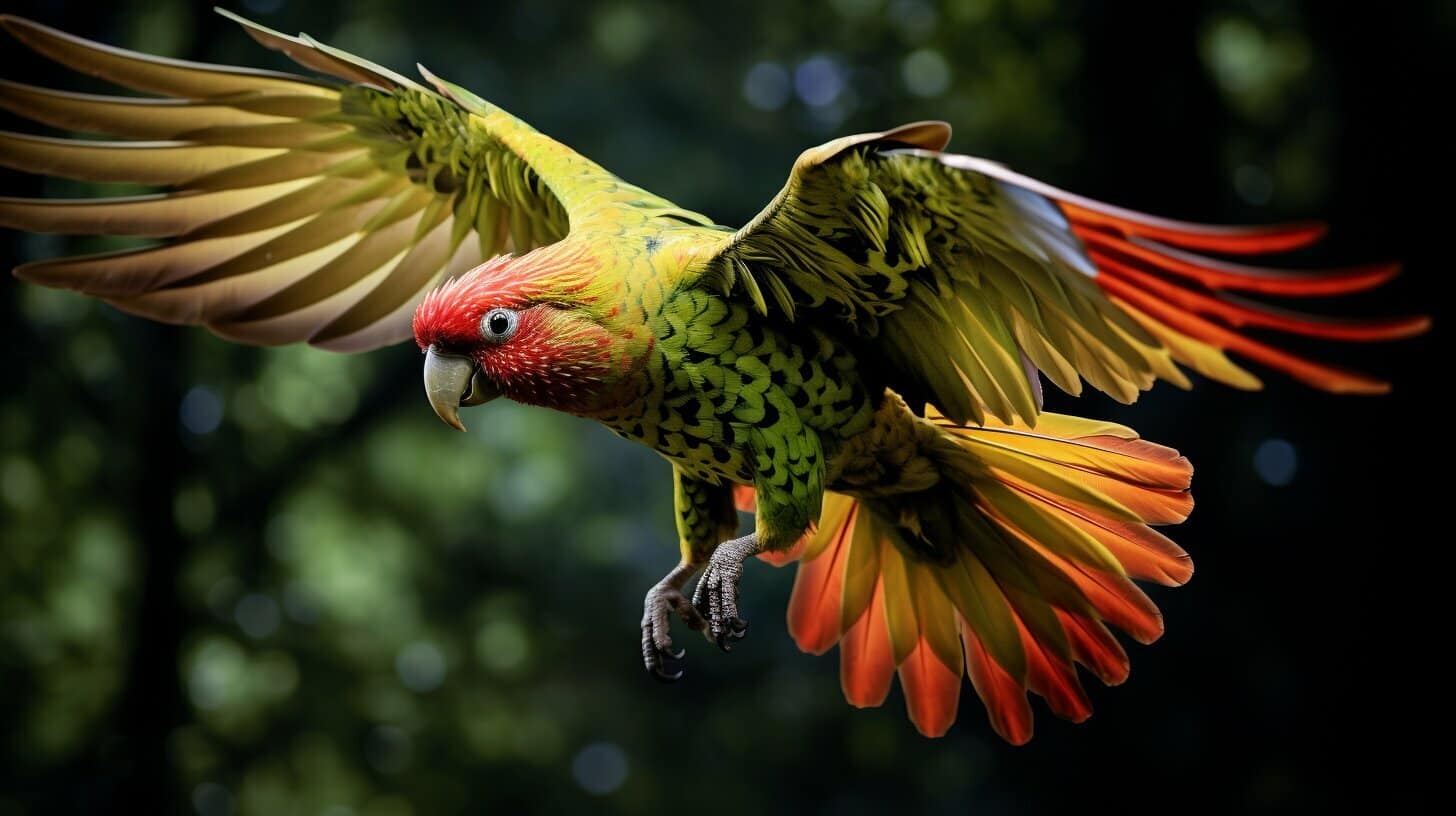How long do Kakarikis live? Kakarikis have an average lifespan of 10 to 15 years in captivity, but with proper care, some can live well into their late teens or early twenties.
Factors such as diet, habitat, genetics, and care can influence their lifespan. A balanced diet, a suitable environment with ample space and enrichment, and regular veterinary check-ups are key to increasing their lifespan.
Avoiding poor nutrition, inadequate living conditions, lack of exercise, stress, and exposure to toxins can also help ensure a long and healthy life for these beloved birds.
Kakarikis are known for their vibrant colours and playful personalities, making them popular among bird enthusiasts. As with any pet, understanding their lifespan and the factors that can impact it is essential for providing the best possible care. In this article, we will discuss the average lifespan of kakarikis, the factors that can affect it, and how to increase their longevity.
Factors Affecting Kakarikis Lifespan
The lifespan of kakarikis can vary depending on several factors. Here are some factors that can influence the lifespan of these colourful birds:
| Factor | Description |
|---|---|
| Diet | A balanced diet that includes fresh fruits, vegetables, and seeds can help ensure the health and longevity of kakarikis. |
| Habitat | Kakarikis thrive in spacious environments that provide ample room for exercise, play, and exploration. An unsuitable habitat can result in stress and health problems that can impact their lifespan. |
| Genetics | Genetic factors can influence the lifespan of kakarikis. For example, birds selectively bred for colour or physical traits may be more susceptible to health problems. |
| Care | Proper care, including regular veterinary check-ups, can help detect and prevent health problems before they become more serious and impact the lifespan of kakarikis. |
Other Factors
Other factors that can affect the lifespan of kakarikis include exposure to toxins, access to clean water, and the overall stress levels in their environment. By providing a suitable environment and taking steps to ensure their health and well-being, you can help increase the lifespan of these beloved pets.
Average Lifespan of Kakarikis
Kakarikis are known to live relatively long lives compared to other parrots. On average, these colourful birds can live up to 10 to 15 years in captivity. However, with proper care and attention, some kakarikis have been reported to live well into their late teens or early twenties.
The lifespan of a kakariki can depend on various factors, such as their diet, environment, and genetics. These factors can also influence the years in which a kakariki can live.
| Factors | Impact on Lifespan |
|---|---|
| Diet | A balanced and healthy diet can extend a kakariki’s lifespan |
| Environment | A suitable environment with adequate space and enrichment can positively impact a kakariki’s lifespan |
| Genetics | Genetic predispositions or mutations can affect a kakariki’s lifespan |
It is important to note that while genetics can play a role in a kakariki’s lifespan, proper care and attention can often outweigh any negative genetic factors.
Factors that May Shorten a Kakariki’s Lifespan
Recognizing the factors that can negatively impact a kakariki’s lifespan is also essential. These include:
- Poor nutrition or diet
- Inadequate living conditions
- Lack of exercise or social interaction
- Stress or anxiety
- Exposure to toxins or other harmful substances
You can increase their chances of living a long and healthy life by avoiding these factors and providing proper care for your kakariki.
How to Increase Kakarikis Lifespan
Kakarikis are hardy and generally healthy birds, with an average lifespan of 10-12 years. However, there are certain steps you can take to help increase their lifespan and ensure they live a long and happy life.
Provide a Balanced Diet
A balanced diet consisting of a variety of fresh fruits, vegetables, and a high-quality pellet or seed mix is essential for maintaining the health and longevity of kakarikis. Avoid feeding them food high in fat, salt, or sugar, and limit treats to occasional, small portions.
Create a Suitable Environment
Providing a suitable habitat for your kakarikis is crucial for their health and well-being. The enclosure should be large enough for them to fly and move around comfortably, and it should be kept clean and dry to prevent the growth of harmful bacteria. Additionally, providing plenty of toys and perches can help keep them mentally and physically stimulated.
Ensure Regular Veterinary Check-Ups
Regular visits to a veterinarian specialising in bird care can help ensure that any potential health issues are caught early and treated promptly. As kakarikis are prey animals, they may mask signs of illness or injury, so it is particularly important to keep a close eye on their behaviour and physical appearance.
By following these simple steps, you can help ensure your kakarikis live long and healthy lives.
Common Health Issues and Lifespan Impact
Kakarikis are generally hardy birds, but like other pets, they can experience health issues as they age. It is important to be aware of common health issues in kakarikis so that they can be addressed promptly and not affect their lifespan.
Psittacosis: This is a bacterial infection that is common in birds. It causes respiratory problems, fever, and lethargy. If left untreated, it can be fatal.
Feather Plucking: Feather plucking is a behavioural disorder in which birds begin to pluck their feathers. This is often caused by boredom or stress, but it can also be a sign of underlying medical issues.
| Common Symptoms of Feather Plucking | Possible Causes |
|---|---|
| Loss of feathers around the neck, chest, and wings | Redness or irritation of the skin where feathers have been plucked |
| Redness or irritation of skin where feathers have been plucked | Medical issues such as allergies, parasites, or hormonal imbalances |
Beak and Feather Disease: This viral disease affects the beak, feathers, and immune systems of birds. It can cause beaks and feathers to become deformed, and birds may become susceptible to other infections due to their weakened immune systems.
Other common health issues in Kakarikis include respiratory, mite, and fungus infections. If you notice any signs of illness in your bird, such as changes in behaviour or lethargy, it is important to seek veterinary care as soon as possible.
Proper diet, hygiene, and regular check-ups can help prevent many of these health issues in kakarikis and improve their lifespan.
Signs of Aging in Kakarikis
Like any other living creature, kakarikis will eventually show signs of ageing. While their lifespan can vary based on several factors, there are some common changes that owners can expect to see as their birds get older.
One of the most noticeable signs of ageing in kakarikis is a change in their behaviour. They may become less active and playful and spend more time resting or sleeping. They may also become less social and less willing to interact with their owners.
Another sign of ageing is a change in physical appearance. Older kakarikis may lose their bright colouring and plumage, and their feathers may become dull or worn. Additionally, they may experience weight or body shape changes and may develop lumps or bumps.
Ageing kakarikis may also experience changes in mobility. They may become less agile, have difficulty moving around, or have trouble perching or flying.
As kakarikis age, their overall health may decline and become more susceptible to illnesses and diseases. Regular check-ups with an avian veterinarian can help detect any health issues early, providing the best chance for treatment and longer life.
If you notice any of these signs in your ageing kakariki, providing them with extra care and support is important. This could include providing a less stimulating environment, adjusting their diet to accommodate changes in appetite, or providing additional perches and support for their mobility.
Frequently Asked Questions (FAQs) about Kakarikis’ Lifespan
As a kakariki owner or someone considering getting one, it’s essential to understand their lifespan and how to ensure they live a long and healthy life. Here are some frequently asked questions about Kakarikis’ lifespan:
Q: How long do kakarikis live?
A: The average lifespan of kakarikis is around 10 to 15 years, but with proper care and attention, they can live up to 20 years or more.
Q: What factors affect the lifespan of kakarikis?
A: Various factors can influence the lifespan of kakarikis, including their diet, habitat, genetics, and overall care. Good nutrition, regular exercise, and proper veterinary attention can help extend their lifespan.
Q: What can I do to increase the lifespan of my kakariki?
A: You can extend the lifespan of your kakariki by providing them with a suitable environment, a balanced and nutritious diet, and regular veterinary check-ups. Additionally, spending time with your bird, providing adequate socialisation, and ensuring they have plenty of exercise can also help improve their health and lifespan.
Q: What are some common health issues that can affect the lifespan of kakarikis?
A: Common health issues that can impact the lifespan of kakarikis include respiratory diseases, fatty liver disease, and feather plucking. Regular vet check-ups, a balanced diet, and a clean environment can help prevent these health issues from developing.
Q: What are some signs of ageing in kakarikis?
A: Signs of ageing in kakarikis include decreased activity, changes in feather colour or texture, cloudy eyes, and decreased mobility. It’s essential to be aware of these changes and take the appropriate steps to support your kakariki’s health and well-being.
Q: What can I do if my kakariki is showing signs of ageing?
A: If you notice signs of ageing in your kakariki, you can best schedule a visit with your avian veterinarian. They can thoroughly examine your bird, diagnose any underlying health issues, and develop a treatment plan to support your bird’s health and well-being.
Remember, by providing your kakariki with good nutrition, a comfortable environment, regular exercise, and veterinary check-ups; you can help ensure they live a long and happy life.



Have comments or questions about this article? Then get involved!
Spotted an error or something we have missed? Let us know